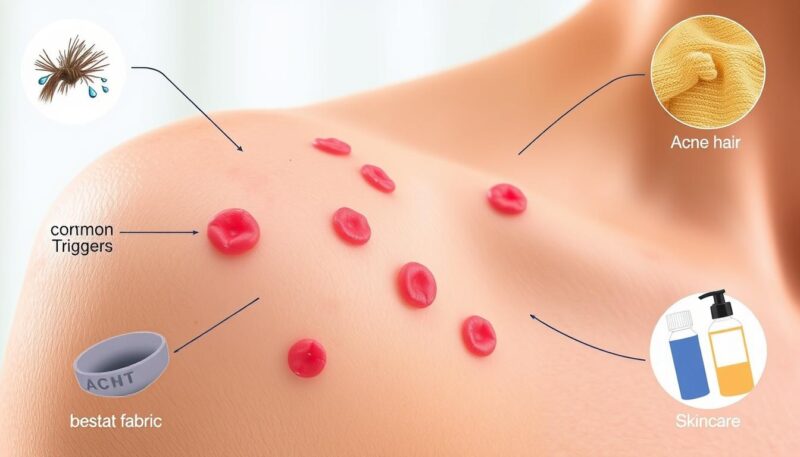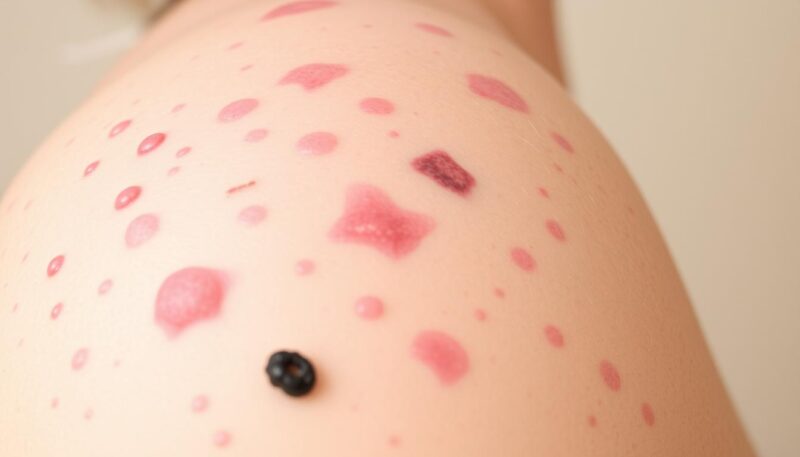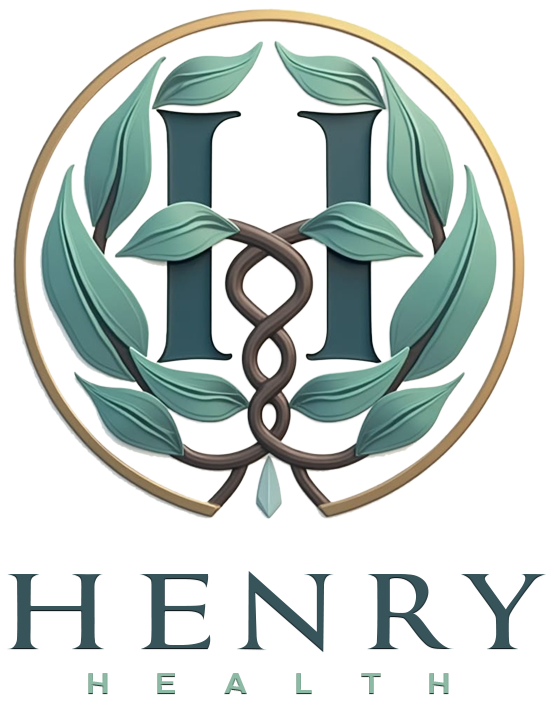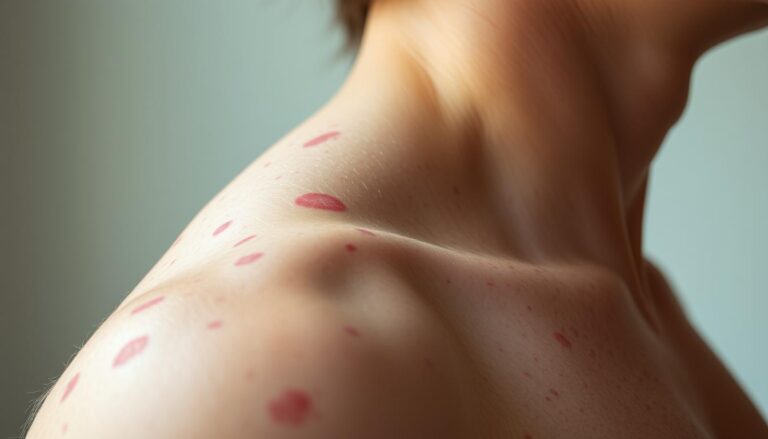Acne on shoulders can be a frustrating condition, impacting not only your skin’s appearance but also your confidence. While shoulder acne may seem less common than facial acne, it actually affects a significant number of people. In fact, approximately 40 to 50 million Americans experience acne at any one time, with many reporting breakouts on their shoulders similar to facial acne or acne on other parts of the body, like the back and neck.
Understanding the causes and effective treatment options for shoulder acne can help you manage and alleviate this condition. Factors contributing to acne on shoulders include hormonal changes, the pressure from backpacks, and even the kind of clothing you wear. Furthermore, hormonal medications like testosterone and certain progesterones can exacerbate the production of sebum, which can lead to increased breakouts.
Despite how prevalent this issue is, many effective shoulder acne treatments and skincare for shoulder breakouts exist. From home remedies like tea tree oil to prescription medications like isotretinoin, knowing your options is crucial for maintaining clear skin. Targeted treatments can offer considerable relief, enabling you to get back to your regular activities without the burden of recurring breakouts. Let’s delve deeper into understanding shoulder acne, its common causes, types, and how you can effectively prevent and treat it.
Introduction to Shoulder Acne
Shoulder acne, also known as acne mechanica, can affect individuals of various ages and backgrounds. The prevalence rates of acne vulgaris among adolescents are estimated to range from 35% to over 90%. Understanding how to treat body acne and identifying the causes of shoulder acne are essential steps in managing this common skin condition.
Shoulder acne typically develops due to several factors such as blocked pores, excessive sebum production, hormonal changes, and external factors like wearing tight clothes. These acne triggers on shoulders can manifest in different forms, including blackheads, whiteheads, papules, pustules, nodules, and cysts. About 50% of individuals with acne experience it on their back, and 15% have outbreaks on the chest as well.
Acne can commence as early as ages 7-12 and often resolves by the third decade of life. However, about 20% of individuals with acne develop severe forms that result in scarring. It is also important to note that males are more commonly affected by adolescent acne, while females predominantly experience postadolescent acne. Addressing acne triggers on shoulders and knowing how to treat body acne effectively can mitigate the severity and frequency of these outbreaks.
The genetic component of acne significantly contributes to its occurrence, with heritability estimates ranging from 50% to 90%. Moreover, urban populations tend to experience higher rates of acne compared to rural populations. Understanding these statistics provides a comprehensive overview of the causes of shoulder acne and aids in developing targeted treatment plans.
In conclusion, recognizing the widespread impact and multifaceted nature of shoulder acne can help you make informed decisions about treatment and prevention. By understanding the underlying causes, you can address acne triggers on shoulders and learn how to treat body acne effectively, ensuring better skin health and confidence.
Common Causes of Acne on Shoulders
Understanding the origins of acne on shoulders is essential for finding effective back and shoulder acne treatments. Many factors can contribute to body acne solutions, and identifying specific acne triggers on shoulders is crucial for managing and preventing breakouts.
Hormonal Changes
Hormonal fluctuations are a significant factor in the development of shoulder acne. During puberty, or due to conditions such as polycystic ovary syndrome (PCOS), the body produces more sebum. Sebum is an oily substance that clogs pores and fosters acne. For instance, high levels of progesterone can lead to an estimated 25% increase in sebum production, which can result in acne formation. Acne is also linked to various hormones, including cortisol, insulin, and growth hormones, which can intensify sebum production when elevated.
External Factors
External factors play a role in exacerbating shoulder acne. Acne mechanica, a type of acne caused by friction and irritation, frequently occurs due to tight-fitting clothing, such as athletic wear, and backpack straps. These elements create friction and trap sweat against the skin, intensifying acne triggers on shoulders. The likelihood of infection or increased inflammation rises due to environmental exposure and the habit of picking at the skin.
Excess Sebum Production
Excess sebum production is a central contributor to shoulder acne. When sebum mixes with dead skin cells and bacteria, it leads to clogged and inflamed pores, particularly in larger areas like the shoulders and back. Back acne is the second-most common location for acne, following facial acne, due to the larger pores which can result in more painful lesions. Effective back and shoulder acne treatments must address this critical cause to manage and mitigate breakouts effectively.

| Statistics | Details |
|---|---|
| Commonality of Acne | 85% of individuals experience some degree of acne between ages 12 and 24. |
| PCOS Prevalence | 6-12% of women suffer from PCOS, often resulting in severe hormonal acne. |
| Acne Mechanica and Clothing | Induced by tight-fitting clothing, it increases acne formation from friction and sweat. |
| Infection Risk | Environmental exposure and picking behavior increase infection likelihood. |
| Activity-Related Acne | 40% increase in acne incidence due to physical activities and lack of immediate cleansing. |
Different Types of Shoulder Acne
Shoulder acne varies widely in appearance and severity, and understanding the different types of shoulder acne can help you choose the right treatment methods. Identifying whether you are facing whiteheads, blackheads, or more severe forms like cysts and nodules is key in treating different acne types effectively. The types of shoulder acne generally include:
- Whiteheads: Small bumps that contain sebum and keratin, appearing as closed comedones where pores are clogged with oil and dead skin cells.
- Blackheads: Open comedones that result in small black dots, formed when contents of clogged pores are exposed to air and oxidized.
- Papules: Red dots smaller than 1 cm, resulting from a buildup of bacteria, oil, and dead skin cells, but without a visible head.
- Pustules: Red lumps with a visible white pus-filled head, which are similar to papules but contain pus.
- Nodules: Larger, painful lumps beneath the skin, caused by deep inflammation and often difficult to treat.
- Cysts: The most severe type of acne, presenting as inflamed and painful blemishes beneath the skin, which may lead to scarring.
Acne vulgaris is the most common form of acne, contributing significantly to issues with shoulder acne due to the overproduction of oil from sebaceous glands. On the other hand, acne mechanica, caused by external factors like friction and heat, is particularly prevalent among athletes. Recognizing these types enables a more targeted approach in treating different acne types on your shoulders.

Here’s a detailed comparison of the different types of shoulder acne to help you choose the right approach:
| Type | Characteristics | Treatment Options |
|---|---|---|
| Whiteheads | Closed comedones, small bumps filled with sebum and keratin | Salicylic acid, benzoyl peroxide, retinoids |
| Blackheads | Open comedones, small black dots from oxidized sebum | Salicylic acid, retinoids, thorough cleansing |
| Papules | Red dots smaller than 1 cm without a clear head | Benzoyl peroxide, topical antibiotics |
| Pustules | Red lumps with a visible white pus-filled head | Benzoyl peroxide, salicylic acid |
| Nodules | Larger, painful lumps beneath the skin | Oral antibiotics, hormonal treatment, isotretinoin |
| Cysts | Inflamed, painful lesions under the skin, potentially leading to scarring | Prescription medications, professional treatments like chemical peels and laser therapy |
Treating different acne types often involves a combination of topical treatments, such as cleansing with salicylic acid or benzoyl peroxide, and prescription medications when necessary. Regular cleansing, avoiding abrasive exfoliants, and maintaining hygiene can significantly help in managing and preventing shoulder acne outbreaks.
Effective Home Remedies for Shoulder Acne
Shoulder acne can be stubborn, but several effective home acne solutions are readily available. Here, we explore natural remedies for shoulder acne, focusing on the benefits of tea tree oil, warm compresses, and oatmeal baths, which have shown promising results in managing this skin condition.
Tea Tree Oil
Tea tree oil for acne is a highly regarded remedy due to its potent antimicrobial properties. A 2019 review noted that tea tree oil products could significantly decrease the number of acne sores. By applying diluted tea tree oil to the affected shoulder areas, you can target acne-causing bacteria and reduce inflammation.
Warm Compress
Applying a warm compress to acne-prone shoulders can promote healing and provide a soothing effect. It can help to open up pores, facilitating the drainage of pus from inflamed acne. This method enhances circulation and accelerates the body’s natural healing process, making it a valuable home acne solution.
Oatmeal Bath
An oatmeal bath is another excellent natural remedy for shoulder acne. Oatmeal has anti-inflammatory properties that can calm irritated skin and reduce the occurrence of breakouts. By soaking in an oatmeal bath, you can relieve the itching and discomfort commonly associated with shoulder acne.
| Home Remedy | Benefits | Study Results |
|---|---|---|
| Tea Tree Oil | Reduces acne sores through antimicrobial action | 2019 review: Significant reduction in acne sores |
| Warm Compress | Promotes pus drainage and speeds up healing | Not specified, but enhanced healing observed |
| Oatmeal Bath | Soothes inflammation and alleviates irritation | Anti-inflammatory properties noted in various reviews |
Utilizing these natural remedies for shoulder acne can offer you effective management options and ease the discomfort associated with shoulder acne. Remember, consistency is key to seeing noticeable improvements over time.
OTC and Prescription Treatments
Managing acne on your shoulders can feel like a daunting task, but understanding your options can make it easier. Over-the-counter (OTC) acne treatments are generally the first line of defense. Popular choices like benzoyl peroxide and salicylic acid can effectively manage mild shoulder acne by clearing pores and reducing inflammation. Benzoyl peroxide is often preferred due to its gentleness and effectiveness, commonly requiring a 6-week course for noticeable results.
For persistent or severe cases, prescription acne medicine may be necessary. Dermatologists often prescribe topical retinoids, such as adaptalene (Differin), which usually require around 6 weeks for noticeable improvement. Additionally, other prescription options include antibiotics, hormonal treatments like birth control pills, and isotretinoin for severe cases. Oral antibiotics can require a treatment duration of 4 to 6 months, with significant improvement typically observed after 6 weeks.
Given the chronic and recurring nature of acne, it’s not uncommon for patients to try several different medications before finding an effective treatment. Treatments may take weeks to show results, and there might be an initial worsening of the condition. Moreover, many topical acne medications increase skin sensitivity to the sun, necessitating cautious sun exposure. Notably, hormonal treatments such as co-cyprindiol may need 2 to 6 months for significant improvements, with unique considerations like a slight increased risk of developing certain conditions.
Understanding the variety of treatment options can empower you to make informed decisions and explore what’s best for your specific situation. Whether you start with OTC acne treatments or seek prescription acne medicine for more severe conditions, patience and consistency in your skincare routine are crucial for successful outcomes.
Preventing Shoulder Acne
Effective strategies for preventing shoulder acne involve a combination of suitable clothing choices, proper hydration, a consistent skincare routine, and other preventative measures. These steps help manage and reduce breakouts, ensuring healthier skin.
Clothing Choices
Opting for loose, breathable fabrics can significantly reduce the likelihood of shoulder acne. Clothes made from materials like cotton and moisture-wicking fabrics help minimize friction and irritation, which are major contributors to acne mechanica. Avoid tight clothing, especially during workouts, to allow your skin to breathe and reduce sweat accumulation.
Hydration and Skincare Routine
Maintaining proper hydration is essential for healthy skin and is a fundamental aspect of skincare for shoulder breakouts. Drinking enough water helps to flush out toxins and keep your skin hydrated from within. A consistent skincare routine involving cleansing, exfoliating, and moisturizing is crucial. Using gentle, non-comedogenic products can prevent clogged pores and manage sebum levels. Incorporate products like salicylic acid or benzoyl peroxide-based cleansers to target acne-causing bacteria effectively.
Other Preventative Measures
Other effective measures include showering immediately after exercise to remove sweat and bacteria, avoiding certain bags or straps that apply pressure to your shoulders, and maintaining clean beddings and clothing. These habits can mitigate the risk of aggravating existing shoulder acne. Additionally, using hypoallergenic detergents and ensuring your skin is protected with SPF during sun exposure can prevent irritation that may lead to acne flare-ups.
By combining these strategies—thoughtful clothing and acne prevention, staying hydrated, maintaining a consistent skincare routine, and adopting additional preventative measures—you can effectively manage and reduce shoulder acne, leading to healthier and clearer skin.
Conclusion
Understanding the varied causes and identifying the specific type of shoulder acne are foundational steps in managing shoulder acne effectively. This skin condition is prevalent, affecting numerous individuals globally, especially those experiencing hormonal fluctuations or excess sebum production. Knowing that acne vulgaris affects approximately 85% of the population at some point underscores the importance of a comprehensive acne care regimen.
A myriad of solutions exists, ranging from simple home remedies like tea tree oil and oatmeal baths to over-the-counter treatments containing salicylic acid and benzoyl peroxide. These methods can significantly reduce inflammation and unclog pores. Moreover, prescription treatments such as topical retinoids and antibiotics can be highly effective for severe cases, offering advanced clear skin solutions for those in need.
Prevention plays an equally crucial role. Regular cleansing, wearing breathable clothing, and showering immediately after exercise are practical steps to minimize breakouts, as friction and pressure contribute to acne mechanica, particularly for athletes. Incorporating non-comedogenic products into your routine can reduce clogged pores and the subsequent formation of acne. Additionally, stress management and dietary considerations, such as reducing high sugar and dairy intake, may further mitigate the condition.
In cases where shoulder acne persists despite adhering to these strategies, seeking professional advice from a dermatologist is advisable. They can provide tailored treatments and interventions to achieve clearer, healthier skin, ensuring a comprehensive approach to managing shoulder acne effectively. By combining these insights and treatments, you can work towards a solution that best suits your individual skin needs.

